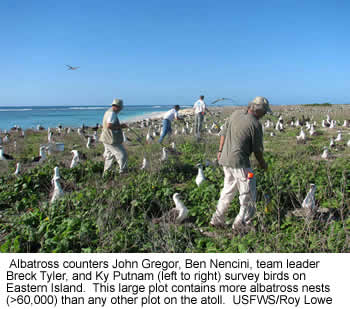 The
annual count of Laysan and black-footed albatross nests by volunteers at
Midway Atoll National Wildlife Refuge has been completed, and the U.S. Fish
and Wildlife Service reports numbers for both species have increased to the
highest level since the count began in 1991. A total of 511,612 nests were
painstakingly counted during a three-week period in December and January. The
annual count of Laysan and black-footed albatross nests by volunteers at
Midway Atoll National Wildlife Refuge has been completed, and the U.S. Fish
and Wildlife Service reports numbers for both species have increased to the
highest level since the count began in 1991. A total of 511,612 nests were
painstakingly counted during a three-week period in December and January.
"We had a great group of counters who were incredibly hard-working," said
Dr. Annie Marshall of the Fish and Wildlife Service's Pacific Islands
office in Honolulu. "More nests meant more work, but it was extremely
rewarding to see the numbers just keep rising."
Though Midway Atoll consists of only 1,540 acres, it hosts the world's
largest populations of Laysan and black-footed albatrosses. The total
number of nests counted this year by island are:
|
Area |
Acres |
Laysan albatross nests |
Black-footed albatross nests |
Totals |
Sand Island |
1,200 |
277,732 |
12,606 |
290,338 |
Eastern Island |
334 |
207,369 |
11,461 |
218,830 |
Spit Islet |
6 |
2,426 |
18 |
2,444 |
Totals |
1,540 |
487,527 |
24,085 |
511,612 |
|
"We are particularly pleased to see an increase in the number of
black-footed albatrosses," said John Klavitter, the refuge"s wildlife
biologist. "This marks the fifth year of increased numbers of black-footed
albatross nests on Midway after fairly steep declines in the 1990s."
Since it is impossible to count individual birds, the volunteers are
assigned sectors on all three islands in which they count active nests.
They move in a line through each section with a mechanical counter and an
inverted paint can, using it to make a tiny dot of orange paint beside each
active nest. The total number of nests multiplied by two represents the
total breeding population, in this case, more than 1 million adults. A 50
percent multiplier is used to approximate the number of albatross on the
atoll, since many unmated birds return to Midway to practice their courting
ritual and eventually find a mate for life.
This year's 21 volunteers came from as far away as Minnesota and
included representatives from Oregon, California, and Hawaii. Each year,
seasoned albatross count veterans are paired with newcomers to ensure
consistent results. "Though the volunteers miss the holidays at home, they
tell us their Midway experience more than makes up for it," Klavitter
explained. "Some of the folks here this year were on a waiting list for 3
years to come to Midway."
In addition to the albatross count, the volunteers were responsible for
a vegetation sampling project and helped remove invasive ironwood trees.
The purpose of the vegetation sampling is to help determine the impact of
invasive plants such as verbesina on albatross nesting. That work is
continuing through the end of January. Volunteers helped pull ironwood
seedlings and cut down small trees from the northern and western shores of
Sand Island to restore albatross nesting habitat. Originally introduced in
the early 1900s as a windbreak, ironwood trees spread over large areas of
the island. Trees adjacent to the airfield runways were removed for safety
reasons, and current efforts are to control their spread into new areas.
As the volunteers return to their homes, the albatross chicks are
hatching at Midway. The first black-footed albatross chick was spotted on
January 16 near the west beach and the first Laysan albatross chick 4 days
later in the town area. Most of the chicks will have hatched within the
next week or so.
"I'll miss seeing the chicks, but we had an incredible experience," said
Marshall. "You're living in the birds' natural environment, surrounded by
their music and dancing. They aren't afraid of people, and accept us as
part of their community. It's always hard to leave".
The 2005-6 count is the sixth complete assessment of Midway's nesting
albatrosses in the last 14 years. Though numbers have fluctuated somewhat
from year to year, the previous record nest counts were 441,178 Laysan
albatross nests in 2003 and 21,645 black-footed albatross nests in 1996.
The International Union for the Conservation of Nature identifies 17 of 21
species of albatross as being at risk, including black-footed and Laysan
albatrosses.
|
Please join us in our
Discussions forums with topics covering Wildlife Rehabilitation,
Birding, Backyard Wildlife and More.
|